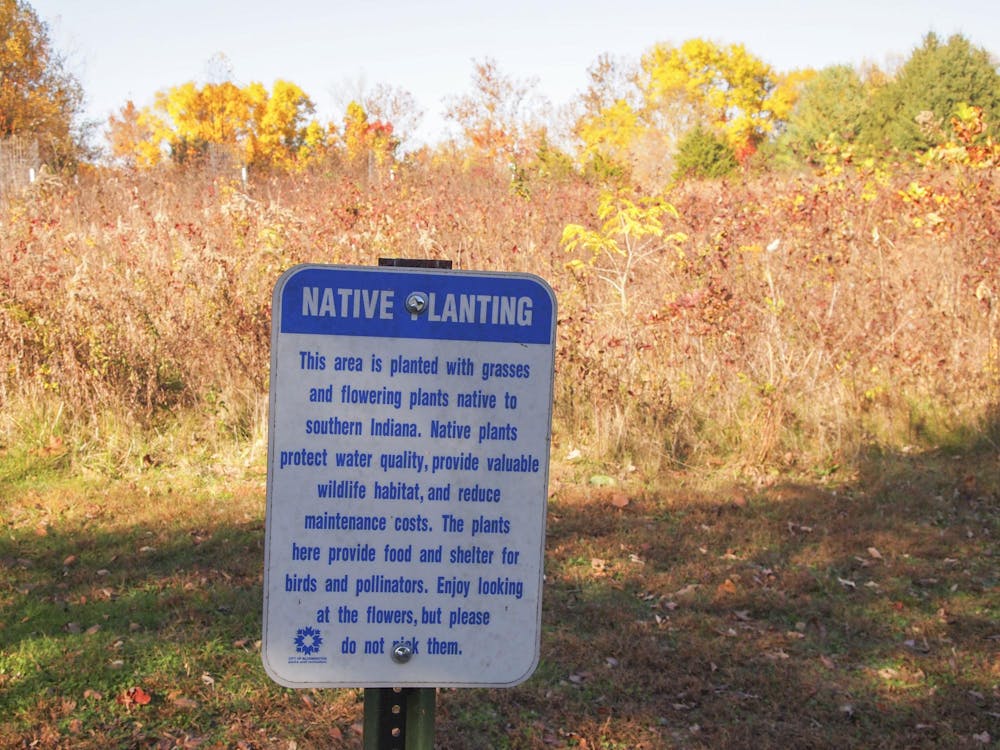A century ago, sugar maple trees were everywhere on IU Bloomington’s campus, with their vibrant red fall foliage making them a statewide staple. They even earned a callout during former U.S. President Theodore Roosevelt's 1918 commencement address, University Landscape Architect Mia Williams said.
But recently, sugar maples have been struggling to thrive due to climate change.
“They’re just not surviving,” Williams said.
Ethan Iversen, president of the Rewild Club at IU, said the maples are struggling with drought and herbal soil conditions: factors that have been aggravated by the increased heat and precipitation brought by climate change.
The loss of the sugar maples is just one example of a wave of ecological deterioration facing Bloomington.
This heat and precipitation also contributed to flooding and an increased frequency of extreme weather events, causing a ripple of damage for ecosystems across the state.
The U.S. Department of Agriculture’s “plant hardiness zones” identify the plants most likely to survive in a given location, based on climate factors. Indiana has already experienced a shift, and experts in Indiana expect another by mid-century.
“I’ve been working about 29 years and we’ve moved a whole zone,” Williams said. “So that’s a whole different group of plants that’s going to thrive.”
Flooding, another consequence of climate change, threatens the infrastructure of the campus’s natural areas. In 2022, Capital Planning and Facilities undertook a two-phase restoration project to fix and prevent damage to the Campus River.
Williams said those repairs were linked to upticks in severe weather.
“We started to realize that the Campus River was getting more frequent storm events, larger volume storm events, faster time of concentration events and it was just blowing up," Williams said. “The banks were getting eroded; we were losing infrastructure, so bridges and abutments were really to the point where they weren't saved.”
Iversen, who is earning a master’s degree in environmental science, worked as a service corps intern with Landscape Services. He said he’s seen the increase in storms cause a greater workload for university personnel.
“We're getting more and more severe storms,” Iversen said. “The arborists, oh my gosh, they're always busy clearing trees that have come down.”
Indiana’s long-term climate outlook indicates these symptoms are just the start. Rising temperatures, increased precipitation and more frequent severe weather are all predicted to worsen over the next decade. This progression will have dire consequences for plants and wildlife.
For IU Bloomington, those consequences cut to the core of the university’s identity.
“Often, the real reason people choose to come to IU is the trees, you know, the fall colors,” Iversen said. “It’s more the natural aspects of campus.”
IU Bloomington’s moniker as the “Woodland Campus” dates back to at least 1966 and is critical to the university’s reputation today.
Williams said she considers campus landscaping an inextricable part of student life. She called this connection an “academic ecosystem” and said it has deep-rooted impacts for the student experience.
“People who get exposure to nature have a better ability to pay direct attention,” Williams said, referring to research showing a positive connection between exposure to nature and mental wellbeing. “I think that is something that IU has that many other universities don’t have.”
Williams said this kind of mutualism is made possible by intentional care and stewardship of natural spaces.
“(Campus) looks natural, and many aspects of it are natural, but if we just turned 40,000 people loose on the campus without taking care of those assets, it wouldn’t look like that,” Williams said.
With the effects of climate change rippling through Indiana’s ecosystems, our stewardship needs to evolve with its circumstances. Hotter weather, flooding rains and worsening storms are creating new demands of campus landscaping.
In Rewild IU, students are trying to help the Bloomington campus meet those demands.
“We function almost like a mini land trust, if you will, for campus,” Iversen said.
Rewild IU evolved from a set of class projects into a club that works with Landscaping Services to help restore undeveloped natural areas on campus, such as woodlots and reconstructed marshlands. The club seeks to promote native plant life in the areas that landscaping doesn’t have the resources to reach.
Iversen said by focusing on these undeveloped locations, Rewild’s student organizers can focus on plant diversity and healthy ecology without concerns about branding and advertising appeal.
“The administration has to worry about, you know, traditional views on what is beautiful,” Iversen said.
Instead, Rewild prioritizes environmental resilience in the face of climate change by planting trees like the Bald Cypress, which can withstand varied conditions, or the Bur Oak, which can live for hundreds of years.
Williams said these kinds of choices have to do with long-term sustainability, and the goal of building a healthy legacy for a future that remains ecologically uncertain.
“What we’re trying to figure out is what’s it going to be like 100 years from now,” Williams said. “That’s what I want to plant. I want to plant the trees that, I know I'm not going to see those trees mature, but I want them to be there for people who will.”




